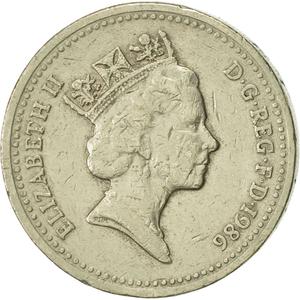By 1980 it had become apparent that with the general decline in purchasing power, the £1 unit of currency was more appropriate to a coin than a banknote. After consultation with many groups including retailers and special interest groups, the Government announced on 31 July 1981 that a new £1 coin that was to be issued on 21 April 1983. Since its launch the £1 has always represented the United Kingdom and its constituent parts; England, Wales, Scotland and Northern Ireland.
The £1 coin in base metal (as opposed to the gold sovereign, which has a nominal face value of one pound too), nickel-brass was introduced in 1983, as a replacement for the £1 banknote. The reverse design of the first £1 coin showed a depiction of the Royal Coat of Arms, representing the United Kingdom as a whole. It was issued until 2015 in rotation with other designs representing Scotland, Wales, Northern Ireland and England, alternating each year in that order.
According to the Royal Mint, "The Northern Ireland £1 coin, the third in the series of four, was introduced into circulation on 21 April 1986. Appropriately, Northern Ireland was represented by the flax plant, whose fibres have - for centuries - been woven into world famous linens." This design was issued again only once, in 1991. Northern Ireland was later represented by the Celtic Cross type of one pound, and the 2014 One Pound with the floral emblem of Northern Ireland.
The design was re-issued in 2008 as a collector coin (in silver and gold) as part of a 14-coin commemorative set marking the 25th Anniversary of the £1 coin.
The coin’s edge inscription is in Latin: DECUS ET TUTAMEN, which may be translated as "an ornament to safeguard".
The coin is made of Nickel-Brass, with composition of 70% copper, 5.5% nickel and 24.5% zinc.
These coins circulated until 2017, when they were demonetised and replaced with the current bimetallic one pound coin. | 





